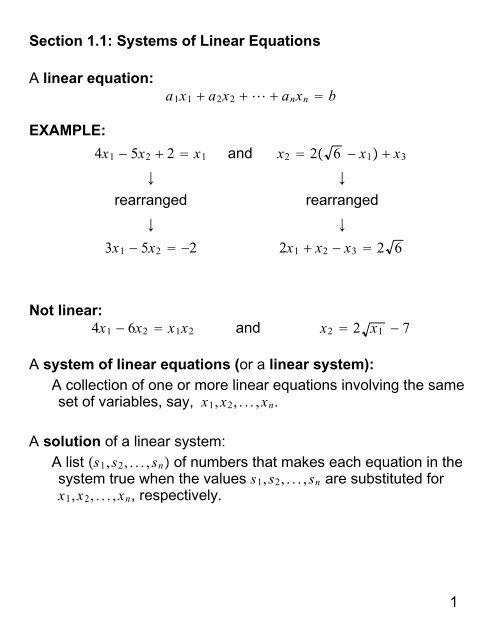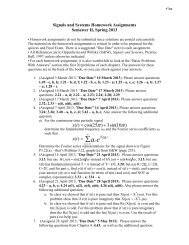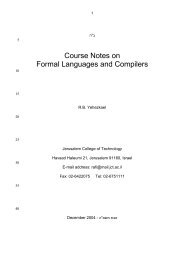Section 1.1: Systems of Linear Equations A linear equation: a1x1 ...
Section 1.1: Systems of Linear Equations A linear equation: a1x1 ...
Section 1.1: Systems of Linear Equations A linear equation: a1x1 ...
- No tags were found...
You also want an ePaper? Increase the reach of your titles
YUMPU automatically turns print PDFs into web optimized ePapers that Google loves.
<strong>Section</strong> <strong>1.1</strong>: <strong>Systems</strong> <strong>of</strong> <strong>Linear</strong> <strong>Equations</strong>A <strong>linear</strong> <strong>equation</strong>:a 1 x 1 a 2 x 2 a n x n bEXAMPLE:4x 1 5x 2 2 x 1 and x 2 2 6 x 1 x 3rearrangedrearranged3x 1 5x 2 2 2x 1 x 2 x 3 2 6Not <strong>linear</strong>:4x 1 6x 2 x 1 x 2 and x 2 2 x 1 7A system <strong>of</strong> <strong>linear</strong> <strong>equation</strong>s (or a <strong>linear</strong> system):A collection <strong>of</strong> one or more <strong>linear</strong> <strong>equation</strong>s involving the sameset <strong>of</strong> variables, say, x 1 ,x 2 ,...,x n .A solution <strong>of</strong> a <strong>linear</strong> system:A list s 1 ,s 2 ,...,s n <strong>of</strong> numbers that makes each <strong>equation</strong> in thesystem true when the values s 1 ,s 2 ,...,s n are substituted forx 1 ,x 2 ,...,x n , respectively.1
EXAMPLE Two <strong>equation</strong>s in two variables:x 1 x 2 10x 1 2x 2 3x 1 x 2 02x 1 4x 2 8x 2−1 1 2 3 4 5 x 11086422 4 6 8 10 x 14321−1−2x 2one unique solutionno solutionx 1 x 2 32x 1 2x 2 6x 24321−1−11 2 3 4 5 x 1−2infinitely many solutionsBASIC FACT: A system <strong>of</strong> <strong>linear</strong> <strong>equation</strong>s has either(i) exactly one solution (consistent) or(ii) infinitely many solutions (consistent) or(iii) no solution (inconsistent).2
EXAMPLE: Three <strong>equation</strong>s in three variables. Each <strong>equation</strong>determines a plane in 3-space.i) The planes intersect in ii) The planes intersect in oneone point. (one solution) line. (infinitely many solutions)iii) There is not point in commonto all three planes. (no solution)3
The solution set: The set <strong>of</strong> all possible solutions <strong>of</strong> a <strong>linear</strong> system.Equivalent systems: Two <strong>linear</strong> systems with the same solution set.STRATEGY FOR SOLVING A SYSTEM: Replace one system with an equivalent system that iseasier to solve.EXAMPLE:x 1 2x 2 1x 1 3x 2 3x 1 2x 2 1x 2 2x 1 3x 2 24
x 2 x 2−10 −5 5 10 x 14422−10 −5 5 10 x 1−2−2−4−4x 1 2x 2 1x 1 3x 2 3x 1 2x 2 1x 2 242−10 −5 5 10−2−4x 1 3x 2 25
Matrix Notationx 1 2x 2 1x 1 3x 2 31 21 3(coefficient matrix)x 1 2x 2 1x 1 3x 2 31 2 11 3 3(augmented matrix)x 1 2x 2 1x 2 21 2 10 1 2x 1 3x 2 21 0 30 1 26
Elementary Row Operations:1. (Replacement) Add one row to a multiple <strong>of</strong> another row.2. (Interchange) Interchange two rows.3. (Scaling) Multiply all entries in a row by a nonzero constant.Row equivalent matrices: Two matrices where one matrix canbe transformed into the other matrix by a sequence <strong>of</strong> elementaryrow operations.Fact about Row Equivalence: If the augmented matrices <strong>of</strong> two<strong>linear</strong> systems are row equivalent, then the two systems have thesame solution set.7
EXAMPLE:x 1 2x 2 x 3 02x 2 8x 3 84x 1 5x 2 9x 3 91 2 1 00 2 8 84 5 9 9x 1 2x 2 x 3 02x 2 8x 3 8 3x 2 13x 3 91 2 1 00 2 8 80 3 13 9x 1 2x 2 x 3 0x 2 4x 3 4 3x 2 13x 3 91 2 1 00 1 4 40 3 13 9x 1 2x 2 x 3 0x 2 4x 3 4x 3 31 2 1 00 1 4 40 0 1 3x 1 2x 2 3x 2 16x 3 31 2 0 30 1 0 160 0 1 38
x 1 29x 2 16x 3 31 0 0 290 1 0 160 0 1 3Solution: 29,16,3Check: Is 29,16,3 a solution <strong>of</strong> the original system?x 1 2x 2 x 3 02x 2 8x 3 84x 1 5x 2 9x 3 929 216 3 29 32 3 0216 83 32 24 8429 516 93 116 80 27 99
Two Fundamental Questions (Existence and Uniqueness)1) Is the system consistent; (i.e. does a solution exist?)2) If a solution exists, is it unique? (i.e. is there one & only onesolution?)EXAMPLE: Is this system consistent?x 1 2x 2 x 3 02x 2 8x 3 84x 1 5x 2 9x 3 9In the last example, this system was reduced to the triangularform:x 1 2x 2 x 3 0x 2 4x 3 4x 3 31 2 1 00 1 4 40 0 1 3This is sufficient to see that the system is consistent and unique.Why?10
EXAMPLE: Is this system consistent?3x 2 6x 3 8x 1 2x 2 3x 3 15x 1 7x 2 9x 3 00 3 6 81 2 3 15 7 9 0Solution: Row operations produce:0 3 6 81 2 3 11 2 3 10 3 6 81 2 3 10 3 6 85 7 9 00 3 6 50 0 0 3Equation notation <strong>of</strong> triangular form:x 1 2x 2 3x 3 13x 2 6x 3 80x 3 3 Never trueThe original system is inconsistent!11
EXAMPLE: For what values <strong>of</strong> h will the following system beconsistent?3x 1 9x 2 42x 1 6x 2 hSolution: Reduce to triangular form.3 9 42 6 h1 3432 6 h41 330 0 h 8 3The second <strong>equation</strong> is 0x 1 0x 2 h 8 3only if h 8 8 0 or h 3. System is consistent3 . 12












